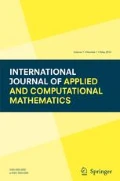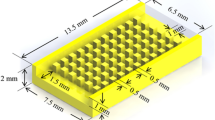Abstract
The paper outlines a numerical method called boundary element method (BEM) which is employed to study heat transfer through the walls of arbitrary shaped heat exchanger tubes having arbitrary shaped holes. The method is implemented for two different cases to obtain the approximate solution of the two dimensional Laplace equation. For both the cases, the inner surfaces are maintained at a constant temperature. However, the outermost periphery is subjected to a constant temperature in the first case and kept at convective condition in the second case. Here the discretization of the boundary produces a system of equations which on solving produce the expression for temperature. The results predicted by BEM are validated with those predicted by Ansys Fluent®. The remarkable accuracy of the results with those obtained from Fluent shows the capability of the method to successfully handle the considered steady-state conduction problem in heat exchanger tubes of multiply connected cross sections. This article uses BEM to study conduction problems in multiply connected exchanger tubes. This work may be extended to study 3D heat conduction through multiply connected tubes.






























































Similar content being viewed by others
References
Atalay, M.A., Aydin, E.D., Aydin, M.: Multi-region heat conduction problems by boundary element method. Int. J. Heat Mass. Transf. 47(6–7), 1549–1553 (2004)
Ang, W.T.: A Beginner’s Course in Boundary Element Methods. Universal Publishers, Boca Raton (2007)
Ang, W.T.: Non-steady-state heat conduction across an imperfect interface: a dual-reciprocity boundary element approach. Eng. Anal. Bound. Elem. 30, 781–789 (2006)
Azevedo, J.P.S., Wrobel, L.C.: Non- linear heat conduction in composite bodies: a boundary element formulation. Int. J. Numer. Meth. Eng. 26(1), 19–38 (1988)
Bouris, D., Papadakis, G., Bergeles, G.: Numerical evaluation of alternate tube configurations for particle deposition rate reduction in heat exchanger tube bundles. Int. J. Heat Fluid Fl. 22(5), 525–536 (2001)
Brackbill, J.U., Kothe, D.B., Ruppel, H.M.: FLIP: a low-dissipation, particle-in-cell method for fluid flow. Comput. Phys. Commun. 48(1), 25–38 (1988)
DeSilva, S.J., Chan, C.L., Chandra, A., Lim, J.: Boundary element method analysis for the transient conduction-convection in 2-D with spatially variable convective velocity. Appl. Math. Model. 22(1–2), 81–112 (1998)
DeSilva, S.J., Chan, C.L.: Coupled boundary element method and finite difference method for the heat conduction in laser processing. Appl. Math. Model. 32(11), 2429–2458 (2008)
Dong, C.Y.: Shape optimizations of inhomogeneities of two dimensional (2D) and three dimensional (3D) steady-state heat conduction problems by the boundary element method. Eng. Anal. Bound. Elem. 60, 67–80 (2015)
Erhart, K., Divo, E., Kassab, A.J.: A parallel domain decomposition boundary element method approach for the solution of large scale transient heat conduction problems. Eng. Anal. Bound. Elem. 30(7), 553–563 (2006)
Gawande, S.H., Wankhede, S.D., Yerrawar, R.N., Sonawane, V.J., Ubarhande, U.B.: Design and development of shell & tube heat exchanger for beverage. Mod. Mech. Eng. 2(04), 121–125 (2012)
Gray, L.J., Lutz, E.D.: On the treatment of corners in the boundary element method. J. Comput. Appl. Math. 32(3), 369–386 (1990)
Grieb, H., Schlosser, W.: Shaped tube with elliptical cross-section for tubular heat exchangers and a method for their manufacture. United States Patent US 4,766,953, 30 Aug 1988
Hantila, F., Vasiliu, M., Maricaru, M., Della, Giacomo A.: Boundary element method for multiply connected domains. J. Mater. Process Tech. 161(1), 315–319 (2005)
Kolodziej, J.A., Strek, T.: Analytical approximations of the shape factors for conductive heat flow in circular and regular polygonal crosssections. Int. J. Heat Mass Transf. 44, 999–1012 (2001)
Königsberger, K.: Analysis 2. Springer, New York (2013)
Lallemand, P., Luo, L.S.: Lattice Boltzmann method for moving boundaries. J. Comput. Phys. 184(2), 406–421 (2003)
Lv, J.H., Feng, X.T., Li, S.J., Jiang, Q., Guo, H.S.: Solid analysis of micron-sized thin structures with BEM for steady-state heat conduction. Eng. Anal. Bound. Elem. 71, 11–19 (2016)
Mera, N.S., Elliott, L., Ingham, D.B., Lesnic, D.: A comparison of boundary element method formulations for steady-state anisotropic heat conduction problems. Eng. Anal. Bound. Elem. 25(2), 115–128 (2001)
Mera, N.S., Elliott, L., Ingham, D.B., Lesnic, D.: The boundary element solution of the Cauchy steady heat conduction problem in an anisotropic medium. Int. J. Numer. Meth. Eng. 49(4), 481–499 (2000)
Moharana, M.K., Das, P.K.: Heat conduction through heat exchanger tubes of noncircular cross section. J. Heat Transf. 130(1), 011301 (2008)
Ochiai, Y., Kitayama, Y.: Three-dimensional unsteady heat conduction analysis by triple-reciprocity boundary element method. Eng. Anal. Bound. Elem. 33(6), 789–795 (2009)
Ochiai, Y.: Two-dimensional steady heat conduction in functionally gradient materials by triple-reciprocity boundary element method. Eng. Anal. Bound. Elem. 28(12), 1445–1453 (2004)
Pérez-Segarra, C.D., Oliet, C., Oliva, A.: Thermal and fluid dynamic simulation of automotive fin-and-tube heat exchangers, part 1: mathematical model. Heat Tansf. Eng. 29(5), 484–494 (2008)
Rana, S.K., Jena, A.: A BEM formulation of two dimensional steady-state heat conduction in exchanger tubes of arbitrary cross sections. Int. J. Heat Mass Transf. 106, 195–211 (2017)
Ruth, E.K.: Experiments on a crossflow heat exchanger with tubes of lenticular shape. J. Heat Transf. 105(3), 571–575 (1983)
Rühlich, I., Quack, H.: Investigations on regenerative heat exchangers. Cryocoolers 10, pp. 265–274. Springer, New York (2002)
Rühlich, I., Quack, H.: New regenerator design for cryocoolers. In: 17th International Cryogenic Engineering Conference, Bournemouth, England, pp. 291–294 (1998)
Shukla, K.N.: Heat pipe for aerospace applications—an overview. J. Electr. Cool. Therm. Control 5(1), 1–14 (2015)
Tanaka, Y., Honma, T., Kaji, I.: On mixed boundary element solutions of convection–diffusion problems in three dimensions. Appl. Math. Model. 10(3), 170–175 (1986)
Vishwakarma, V., Das, A.K., Das, P.K.: Steady-state conduction through 2D irregular bodies by smoothed particle hydrodynamics. Int. J. Heat Mass Transf. 54(1), 314–325 (2011)
Wei, W., Pellischek, G.: Teardrop-shaped heat exchange tube and its process of manufacture. United States Patent US 5,355,946, 18 Oct 1994
Author information
Authors and Affiliations
Corresponding author
Rights and permissions
About this article
Cite this article
Rana, S.K., Mishra, B. & Jena, A. Numerical Investigation of Steady-State Heat Conduction in Arbitrary Shaped Heat Exchanger Tubes with Mutliply Connected Cross Sections. Int. J. Appl. Comput. Math 4, 21 (2018). https://doi.org/10.1007/s40819-017-0456-8
Published:
DOI: https://doi.org/10.1007/s40819-017-0456-8




